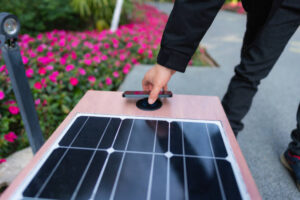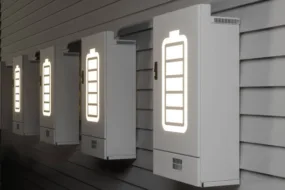Solar energy tracker:

Imagine maximising your solar panel’s potential by constantly keeping it perfectly aligned with the sun. An advanced solar energy tracker does just that! By automatically adjusting the panel’s position throughout the day, you can significantly increase your solar power generation.
Building a solar energy system is a fantastic way to tap into clean, renewable energy. But did you know you can significantly boost your solar panel’s output by building a solar energy tracker?
This comprehensive guide empowers you to build your very own advanced solar energy tracker. We’ll delve into the benefits and challenges you may encounter. So, grab your tools and get ready to unlock the full potential of your solar panels!
What is a solar energy tracker?
A solar energy tracker is a motorised system that automatically adjusts your solar panels’ position throughout the day. By constantly facing the sun directly, your panels capture the maximum amount of sunlight, increasing your energy production by 20–40% compared to fixed-tilt panels!
How can you build your solar energy tracker?
While commercially available trackers exist, building your own offers several advantages:
i. Cost-effective: Do-it-yourself trackers are significantly cheaper than pre-built options.
ii. Customisation: You can tailor the design to your needs and available space.
iii. Educational Project: Building your tracker is a rewarding learning experience about solar technology and automation.
Read More: Exploring the Risks Linked with Natural Gas Investment
Benefits of a Solar Energy Tracker

Traditional, fixed solar panels capture sunlight effectively during peak sun hours, but their efficiency drops significantly as the sun moves across the sky. To combat this, a solar energy tracker constantly adjusts the panel’s angle to face the sun directly. The advantages are undeniable:
i. Increased Energy Production: Studies by Soleos Solar Energy show that solar trackers can boost energy output by a whopping 20–40% compared to fixed panels. This translates to significant cost savings on your electricity bills.
ii. Reduced Energy Loss: As the sun’s angle changes, fixed panels experience increased energy loss due to reflection and refraction. Trackers mitigate this loss by capturing sunlight throughout the day.
iii. Year-Round Optimisation: No matter the season, a solar tracker adapts to the sun’s position, ensuring optimal energy generation all year long.
iv. Unlocking Potential in Shaded Areas: Even in locations with some shade, trackers can significantly improve energy production by following the sun’s path and capturing more sunlight during the day.
Applications of a Solar Energy Tracker
Solar energy trackers aren’t just for homes! Their ability to maximise power generation makes them ideal for a variety of applications, including:
i. Residential Solar Systems: Homeowners looking to get the most out of their solar investment can greatly benefit from a tracker.
ii. Commercial and Industrial Applications: Businesses with large-scale solar installations can significantly increase their energy production with trackers, reducing reliance on the grid and lowering energy costs.
iii. Off-Grid Power Systems: For those living off the grid, maximising solar power capture is crucial. Trackers ensure optimal energy generation for self-sufficient living.
iv. Remote Locations: In areas with limited access to grid power, solar trackers can provide a reliable and efficient source of renewable energy.
Understanding the Challenges

While solar energy trackers offer numerous benefits, there are a few challenges to consider:
i. Initial Cost: Building a tracker requires additional materials and potentially stronger motors compared to fixed panels, leading to a higher upfront cost.
ii. Complexity: The design and construction of a tracker involve more intricate components compared to fixed panels.
iii. Maintenance: To ensure smooth operation, trackers have moving parts that may require occasional maintenance.
iv. Wind Considerations: In areas with strong winds, the tracker’s structure needs to be robust enough to withstand wind gusts without compromising the solar panel’s safety.
Read More: How Coal Oil Lamps Have Changed Over the Years
A Step-by-Step Guide to Building an Advanced Solar Energy Tracker
Now that you understand the advantages and considerations, let’s dive into the exciting world of building your solar energy tracker!
Here’s a breakdown of the process:
1. Planning and designing:
i. Research: Familiarise yourself with different tracker designs (single-axis vs. dual-axis) and choose one that suits your needs and location.
ii. Sizing: Consider the size and weight of your solar panel when designing the tracker’s structure. You’ll need sturdy materials to support the panel securely.
iii. Materials List: Gather the necessary materials like motors, sensors, microcontroller boards (e.g., Arduino), structural components (e.g., metal brackets, wood), and wiring.
2. Building the Tracker Structure:
i. Assemble the Frame: Create a sturdy frame using metal or wood, ensuring it can withstand the weight of the solar panel and resist wind loads.
ii. Motor and Sensor Mounting: Mount the motors (one for single-axis, two for dual-axis) and light sensors (usually light-dependent resistors, or LDRs) in a way that allows them to move the panel freely and accurately track the sun’s position.
3. Programming the Control System
i. Microcontroller: You’ll programme it to receive data from the light sensors (LDRs), which detect the sun’s direction. Based on this data, the programme will send signals to the motors, instructing them to adjust the panel’s angle to maximise sunlight capture.
ii. Coding Resources: There are numerous online resources and tutorials available that provide sample code specifically designed for solar energy trackers using Arduino or other popular microcontroller platforms. These resources can guide you through the programming process, even if you’re a beginner.
4. Calibrating and Testing:
i. Initial Calibration: Once assembled, you’ll need to calibrate the tracker. This involves setting the panel’s starting position and fine-tuning the sensor readings to ensure the tracker accurately follows the sun’s path.
ii. Testing and Adjustments: Throughout the day, monitor the tracker’s operation and make adjustments to the programme or hardware if needed. The goal is to achieve smooth and precise panel movement as it tracks the sun.
5. Safety Considerations:
i. Electrical Safety: When working with electrical components, prioritise safety by following proper electrical safety guidelines.
ii. Sturdy Construction: Ensure that the tracker’s structure is robust enough to withstand wind and other environmental factors. The solar panel should be securely mounted to prevent any risk of falling or damage.
6. Assembly Steps:
i. Construct the Frame: Design and build a sturdy frame that will hold the solar panel and allow for tilting movement using the servo motor.
ii. Mount the servo motor: Secure the servo motor to the frame in a way that allows it to tilt the panel along the desired axis (usually horizontally).
iii. Attach the LDRs: A panel should not shade the LDRs, so mount them on opposite sides of the frame.
iv. Wire Up the Electronics: Connect the microcontroller, servo motor, and LDRs using jumper wires, following a pre-designed circuit diagram specific to your chosen microcontroller.
v. Programming the Microcontroller: Here’s where the magic happens! You’ll need to programme the microcontroller to read the signals from the LDRs and adjust the servo motor accordingly, constantly tilting the panel towards the stronger sunlight. There are plenty of online resources and pre-written code available for Arduino and Raspberry Pi that you can adapt for your project.
Read More: How Bladeless Wind Turbines and Solar Windows Work
Additional Tips and Considerations

i. Start Small: For beginners, consider building a single-axis tracker, which is simpler to design and operate compared to a dual-axis tracker.
ii. Weatherproofing: If you live in an area with harsh weather conditions, consider using weatherproof materials for the tracker’s frame and electrical components.
iii. Safety Shut-Off Switch: To disconnect power from the tracker for maintenance or emergencies, install a safety shut-off switch to disconnect power from the tracker for maintenance or emergencies.
iv. Remote Monitoring: Explore options for remotely monitoring your tracker’s performance using additional sensors and wireless communication modules to monitor your tracker’s performance.
Conclusion
Building your advanced solar energy tracker is a rewarding and educational project. By following these steps and carefully considering the design and construction aspects, you can unlock the full potential of your solar panels and significantly boost your renewable energy generation. Remember, with careful planning, a little ingenuity, and this guide as your roadmap, you can harness the power of the sun more efficiently than ever before!









